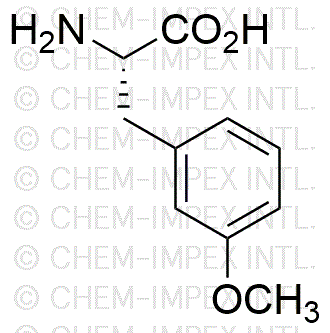L-3-Methoxyphenylalanine is widely utilized in research focused on:
- Neuroscience Research: This compound is studied for its potential effects on neurotransmitter systems, particularly in understanding mood disorders and neurodegenerative diseases.
- Pharmaceutical Development: It serves as a building block in the synthesis of novel drugs, especially those targeting metabolic pathways and neurological functions.
- Biochemical Studies: Researchers use it to investigate protein interactions and enzyme activities, providing insights into cellular processes and disease mechanisms.
- Food Industry: Its properties are explored in the development of flavor enhancers or nutritional supplements, appealing to health-conscious consumers.
- Cosmetic Formulations: The compound is examined for its antioxidant properties, making it a candidate for skin care products aimed at improving skin health and appearance.
Información general
Propiedades
Seguridad y normativas
Aplicaciones
L-3-Methoxyphenylalanine is widely utilized in research focused on:
- Neuroscience Research: This compound is studied for its potential effects on neurotransmitter systems, particularly in understanding mood disorders and neurodegenerative diseases.
- Pharmaceutical Development: It serves as a building block in the synthesis of novel drugs, especially those targeting metabolic pathways and neurological functions.
- Biochemical Studies: Researchers use it to investigate protein interactions and enzyme activities, providing insights into cellular processes and disease mechanisms.
- Food Industry: Its properties are explored in the development of flavor enhancers or nutritional supplements, appealing to health-conscious consumers.
- Cosmetic Formulations: The compound is examined for its antioxidant properties, making it a candidate for skin care products aimed at improving skin health and appearance.
Documentos
Hojas de datos de seguridad (HDS)
La SDS proporciona información de seguridad completa sobre la manipulación, el almacenamiento y la eliminación del producto.
Especificación del producto (PS)
La PS proporciona un desglose completo de las propiedades del producto, incluida la composición química, el estado físico, la pureza y los requisitos de almacenamiento. También detalla los rangos de calidad aceptables y las aplicaciones previstas del producto.
Certificados de análisis (COA)
Busque certificados de análisis (COA) ingresando el número de lote del producto. Los números de lote y de partida se pueden encontrar en la etiqueta de un producto después de las palabras "Lote" o "Lote".
Número de catálogo
Número de lote/lote
Certificados de origen (COO)
Este certificado de origen confirma el país en el que se fabricó el producto y también detalla los materiales y componentes utilizados en él y si se deriva de fuentes naturales, sintéticas u otras fuentes específicas. Este certificado puede ser necesario para cumplir con las normativas aduaneras, comerciales y regulatorias.
Número de catálogo
Número de lote/lote
Hojas de datos de seguridad (HDS)
La SDS proporciona información de seguridad completa sobre la manipulación, el almacenamiento y la eliminación del producto.
DownloadEspecificación del producto (PS)
La PS proporciona un desglose completo de las propiedades del producto, incluida la composición química, el estado físico, la pureza y los requisitos de almacenamiento. También detalla los rangos de calidad aceptables y las aplicaciones previstas del producto.
DownloadCertificados de análisis (COA)
Busque certificados de análisis (COA) ingresando el número de lote del producto. Los números de lote y de partida se pueden encontrar en la etiqueta de un producto después de las palabras "Lote" o "Lote".
Número de catálogo
Número de lote/lote
Certificados de origen (COO)
Este certificado de origen confirma el país en el que se fabricó el producto y también detalla los materiales y componentes utilizados en él y si se deriva de fuentes naturales, sintéticas u otras fuentes específicas. Este certificado puede ser necesario para cumplir con las normativas aduaneras, comerciales y regulatorias.


